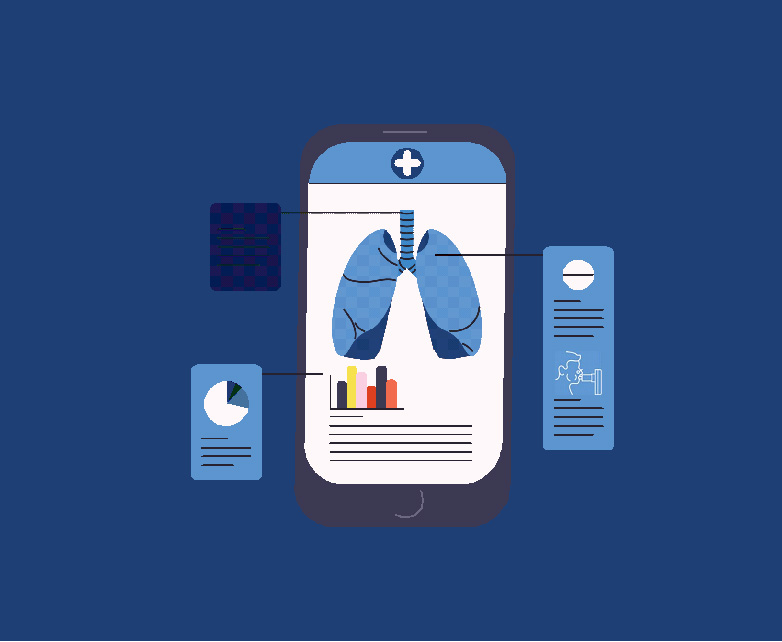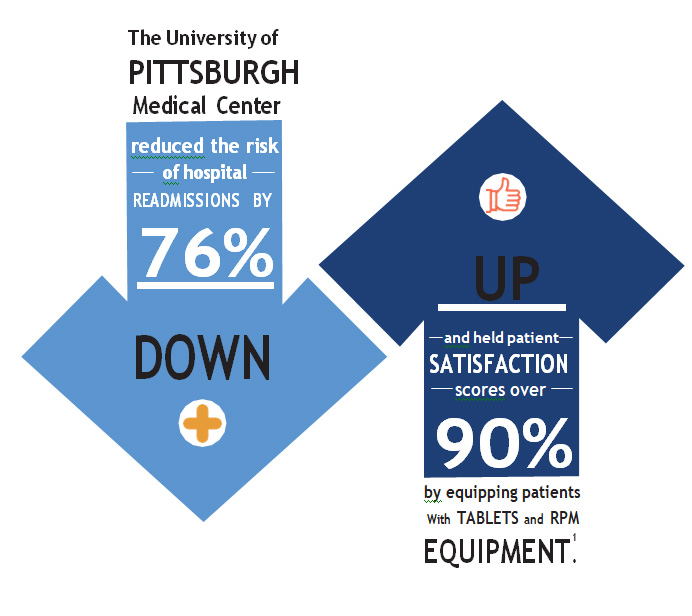
Introduction
The need for remote health monitoring accelerated with the onset of the COVID-19 pandemic. Telehealth solutions have become essential in order to mitigate patient and provider exposure while continuing to provide quality care, especially for individuals with chronic respiratory conditions such as COPD, cystic fibrosis, interstitial lung disease and asthma. Patients and providers have come to expect remote care options that are convenient and maximize safety.
For health care providers and researchers, remote respiratory monitoring (RRM) is an invaluable means of increasing access to care and conducting clinical trials by allowing pulmonary function testing (PFT) to be conducted remotely.
This guide provides an introduction to remote respiratory monitoring—what it is and how it can benefit patients, providers and researchers. It includes information about how to choose a RRM solution to deliver comprehensive care, increase patient adherence and make it easy and convenient to track pulmonary health.
What is remote respiratory monitoring?
Remote respiratory monitoring is an extension of remote patient monitoring that is specific to tracking pulmonary health in chronic respiratory and neurodegenerative conditions such as asthma, COPD, cystic fibrosis and amyotrophic lateral sclerosis (ALS). Remote patient  monitoring is broadly defined as technology that is used to monitor patient information outside of a clinical setting (e.g., in-home). With RRM, a portable Bluetooth spirometer connected to a smartphone or tablet app is used to conduct a patient’s PFT remotely. Since maximal effort is the goal for an optimal PFT, RRM users benefit from a telehealth function to connect the clinical team (e.g., respiratory therapist) or researcher with the patient. This is typically achieved through video conferencing.
monitoring is broadly defined as technology that is used to monitor patient information outside of a clinical setting (e.g., in-home). With RRM, a portable Bluetooth spirometer connected to a smartphone or tablet app is used to conduct a patient’s PFT remotely. Since maximal effort is the goal for an optimal PFT, RRM users benefit from a telehealth function to connect the clinical team (e.g., respiratory therapist) or researcher with the patient. This is typically achieved through video conferencing.
a healthcare delivery method that uses technology to monitor patient health outside of a traditional clinical setting. It refers to the specific technology used to electronically transmit information between patients and physicians.1
sometimes called telemedicine enables a doctor to provide care without an in-person office visit. Telehealth is done primarily online with internet access on a computer, tablet or smartphone.2
How RRM can benefit patients, health care practices and clinical research
Patients
As patients prioritize convenience and safety, frequent in-person visits to a healthcare provider have become more of a burden. There are many challenges to accessing in-person care including mobility and transportation limitations, cost, time burden and exposure to communicable disease. If an in-person visit is not medically necessary, patients prefer remote options. RRM facilitates independence and gives patients an active way to manage their own health while reducing their risk and eliminating travel costs. They are able to use their personal spirometer to conduct a pulmonary function test at home, at work or on the go. They can easily connect with their provider via video, understand their results and be proactive about managing their respiratory health.

Health care practices
On-site pulmonary function tests can be burdensome for patients. Visits and travel take time out of a patient’s day and testing costs have risen sharply.
In-person PFTs also put vulnerable patients at risk, especially during outbreaks of airborne diseases like COVID-19, influenza and respiratory syncytial virus (RSV), but PFTs are necessary to inform critical care decisions. By offering a RRM solution, providers can improve care delivery, increase patient engagement and satisfaction, and add a new revenue source with patient-initiated spirometry reimbursement.
A robust RRM solution can provide real-time trend monitoring and reporting with the ability to view current and historical data points easily, enabling informed and accelerated clinical decision-making. Through video-based PFTs, health care providers can coach patients on testing technique and encourage maximal effort, enabling a patient to perform a supervised PFT as if on-site. Since the pulmonary function test can be done at the patient’s convenience from any location, remote respiratory monitoring eliminates the risks of no-shows or late arrivals, the need for disinfection and deep cleaning of rooms between patients, and the removal and disposal of personal protective equipment—providing staff with more time and resources to focus on patient care. Further, use of innovative features like gamification can motivate patients to perform breathing exercises without prompting or direction, and record progress between visits.
Clinical trials
A remote respiratory monitoring solution can dramatically improve the success of clinical research. Conducting studies using RRM increases participation, standardizes methods across multiple sites and reduces in-lab testing costs. Participation drop-offs occur frequently and sponsored travel is costly. Increased disinfection measures during outbreaks like COVID-19 can add to expenses and inefficiency. By eliminating on-site visits through the use of a single, reliable remote solution, running trials can be more cost-effective while employing consistent methodology.
Study design can include more frequent PFTs and more easily incorporate global participants. The added benefit of over-reading administered by an independent team to validate the readings performed by study researchers can further guarantee the accuracy of respiratory tests performed using a RRM solution.

How to choose a remote respiratory management solution
An RRM solution should enable clinical teams to effectively monitor respiratory health for a variety of medical indications including ALS, asthma, COPD,
cystic fibrosis, COVID-19 recovery and environmental exposures. By choosing the right solution partner, you will be empowered to deliver increased access to
quality care with lab-equivalent monitoring capabilities. To assist with evaluating RRM solutions to offer to patients, the following are key considerations to keep in mind.
Ease of use
All key pulmonary function test parameters must be available through the solution as part of remote PFTs. The ability to easily connect with patients live via video to ensure proper use and coach them through their PFT is another important consideration. Getting the device to patients needs to be streamlined and convenient. Evaluate how a potential partner will handle logistics and simplify your workflow.
Security and reliability
The RRM solution should include an FDA-cleared and CE-marked spirometer that has been validated against in-lab spirometers. The ability to deliver real-time PFT results securely through a cloud-based dashboard is important along with data encryption and adherence to privacy regulations (e.g., HIPAA, GDPR). The RRM provider should offer remote management of smart devices to keep them updated on the latest operating systems and secure. Check to see if they are able to support multiple languages as this becomes important to provide more inclusive care to patients.
Level of support
Determine if technical and billing support services are offered along with training services. Choose an RRM solution provider that will help navigate reimbursement, make it as simple as possible and provide appropriate documentation for reimbursement submissions.
Conclusion
Technology advancements have changed the means by which patient care can be delivered as well as increase access to it in novel ways. The COVID-19 pandemic accelerated the need to provide convenient and safe options like telehealth and remote monitoring, and established patient expectations around remote care.
Remote respiratory monitoring is fast becoming a crucial means of accurately assessing lung health, improving quality of care and achieving better health outcomes. RRM increases patient engagement and independence by enabling patients to play an active and informed role in the management of their health and well-being.
References
- Insider Intelligence—The technology, devices, and benefits of remote patient monitoring in the healthcare industry, Shelagh Dolan, July 28, 2021. <https:// insiderintelligence.com/insights/remote-patient-monitoring-industry- explained/>
- HHS.Gov—What is telehealth? -For patients <https:// telehealth.hhs.gov/patients/understanding-telehealth/?gclid
=CjwKCAiAhreNBhAYEiwAFGGKPEuXSNOCBAykuOLT0GPe_ fGLmBbF75PDI6XvRoIiuYiQIZNuQf9E7RoCWpAQAvD_BwE>
 Author: Jenn Celio, VP Clinical Partnerships of ZEPHYRx
Author: Jenn Celio, VP Clinical Partnerships of ZEPHYRx
Contact: jenn@zephyrx.com
Jennifer Celio, MPH, MS, OTR has 20 years of health care experience comprised of occupational therapy and assistive technology clinical practice, digital health startups, public health advocacy and academia. Her interests include increasing patient engagement and access to care through end-user driven technology.





